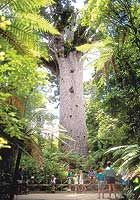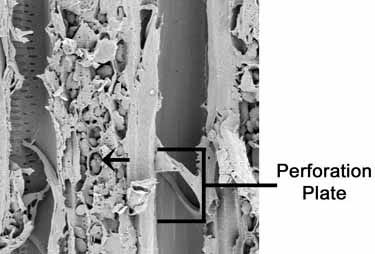Tuesday, April 19, 2005
The other kingdom
I think the science arm of the blogosphere does a pretty good job, it's certainly a group I'm proud to consider myself a very small part of. However there is one area in which this new medium is sadly lacking. To my knowledge there is not a single botany blog out there. While the biological wonders of humans, squids, viruses and even dinosaurs are beamed by RSS to hundreds of newsreaders each morning the stately sequoia remains underexposed and the angiosperm's rapid rise to evolutionary dominance uncharted. Consider this post my small attempt to redress this oversight

The tree to the left of this text is Tane Mahuta - a 2 000 year old Kauri (Agathis australis) named for the Maori god of the forest. The reason I've included a picture of it here is that it epitomizes one of the problems every plant faces - getting water from the soil to their leaves.
Plants grow from the tip of their shoots and derive energy from their leaves - each tissue require water to function. The tip of each shoot contains a population of cells called a meristem which actively divides, leaving daughter cells in its wake. The daughter cells undergo modifications that make them develop into the various tissues (bark, xylem, phloem, sclerenchyma...) that make up an adult plant and the meristem keeps on going. To me at least this is a very alien way to grow, the meristem is like the head of a comet, charging ever upward as it leaves a tail of developing plant behind it.
Tane needs to get water from the soil its roots sit in all the way up its massive trunk to power that growth and provide water for the photosynthetic leaves to generate energy. In some Australian eucalypts this can a trip of 150 metres.
The first thing you are going to need if you want to move water around is a pipe. In plants pipes are called xylem vessels and are made from tracheary elements. As a plant cell divides from its meristem it begins to form a wall of cellulose around itself, this is called the primary cell wall. The tube shaped cells that give rise to tracheary elements lay down a secondary wall of lignin in either circles or spirals inside the primary cell wall to reinforce it. Once this secondary wall is laid down the cell reaches maturity, by dieing. The cell is rapidly degraded by its own chemicals, leaving the lignified cell wall behind like a cellular skeleton. Many of these skeletons line up with perforated ends facing each other to form the xylem vessels that will act as pipes in carrying water around the plant. Here's what a scanning electron microscope makes of two tracheary elements divided by perforated ends and making a portion of a vessel:

The area labelled 'perforation plate' is the boundary between two cells, this pattern is repeated many times over to form a vessel.
So, the suicidal cells of the tracheary elements have given us the pipes in which to transport water. Actually pushing it around still provides a significant problem. Animals, faced with the similar problem of transporting blood to their brain, have developed the heart - a machine which actively pumps blood against gravity. Plants are a little more subtle in their ways, opting to take advantage of physics rather than build a machine to fight against it. They use some of the physical properties of water molecules and the process of osmosis to get water flowing against gravity.
Osmosis is the flow of water from an area of high concentration to one of lower concentration. If the idea of highly concentrated water sounds a little odd just think of it as more pure water. In high school you may have studied this by taking an onion cell - which is basically a bag of chemicals dissolved in water - and surrounding it with pure water on a microscope slide. The cell should have inflated as water flowed in from the pure water around the cell to the relatively impure water on the inside. Animal cells will even explode when subjected to pure water. Plants take advantage of osmosis at either end of their fight to move water. First, roots have loads of dissolved chemicals (solutes in the chemical parlance) meaning the water in the soil is bound to be more pure than that in the roots and as a consequence water will flow into the root hairs, through the root cortex and into the bottom of the xylem vessels. Meanwhile further up the stem the plant exposes its leaves to the sun, since there is so much surface area on display lots of water evaporates. The evaporating water leaves the leaf but the solutes remain, meaning the net effect on the leaf is a lower concentration of water and any nearby water will flow in to redress the balance. The plant has a positive pressure "pushing" water into at the bottom and a negative one at the top "sucking" water up through the plant.
As you have probably worked out the xylem vessels are used to join up the positive pressure from below and the negative pressure above. The system can work because at a molecular level water, despite its famed slipperiness, is very sticky. That is to say there is an electrical attraction between the two hydrogen atoms of one water molecule and the oxygen atom of another one. When a water molecule rushes into a leaf to try and replace an evaporated one it tends to pull others along in the same direction. Since the xylem vessels form a continuous water column all the way up the plant the pull from the top is translated all the way down the column and water travels up the plant, the bottom of the column is replaced by the positive pressure at the root.
That strikes me as a particularly elegant solution to a particularly difficult problem. But it's just the tip of the ice berg. I really know very little plant biology but I do know that there is a great story to be told about the evolution of the system I've just outlined (mosses and the like move water about in a related but different way.) I know there's another, similar, story to be told about the role of phloem in moving nutrients around. I know there's a great story in the lengths leaves go to actively control the rates at which they lose water and gain carbon dioxide. Plants have as many great stories as their distant heterotrophic cousins the animals and I for one hope I read a few more of them soon.
13 Comments:
You are of course right about mycology's under representation. Sadly I know even less about fungi than I do about plants. And then there's the Protista...
Osmotic transport isn't enough to explain anything other than bryophytes, if I remember correctly. I'm pretty sure (but could be wrong!) that the cohesion-adhesion-tension theory David elaborated on is sufficient to explain redwoods. I know there's other issues like fog condensation and runoff but those don't have to do with upward transport.
I admit I haven't gone back to Raven to check :-)
And BTW, I did post on Gymnosporangium a month ago. I have a feeling though that David is thinking of harder botany than I usually get into.
Not all, that’s exactly what I’d love to see more of. There should be everything from pictures of pretty flowers to stories about everything from lifecycles to ecologies to plant’s biochemical tricks. Perhaps we should start a ‘garden’ to go along with Modulator’s Ark
I have to read up a little bit more on how plants move their water around, wouldn’t want to be misleading people
Promocje związane z czyszczenie katowice ślask sosnowiec jest na prawdę tanie.
Czyszczenie odbywa się na mokro. Dywan, tapicerka samochodowa i meblowa. Czyść spontanicznie i nie nerwowo ale pewnie i tanio.












